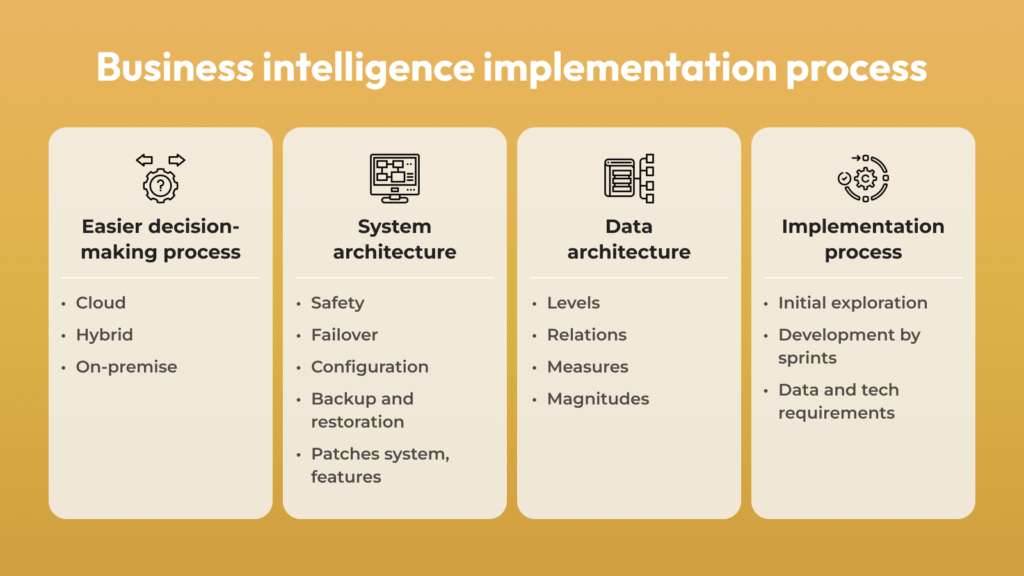In today’s fast-paced digital landscape, businesses are handling massive amounts of data daily. However, raw data alone doesn’t drive success—companies need actionable insights to improve efficiency, boost customer satisfaction, and gain a competitive edge. Business Intelligence (BI) provides the tools and strategies to convert complex data into meaningful business insights, allowing organizations to make informed decisions. This article explores what Business Intelligence is, its various types, key benefits, and the steps to implement it effectively in your business.
What is Business Intelligence?
Business Intelligence (BI) is a combination of technologies, strategies, and tools that help businesses collect, process, and analyze data to support decision-making. By leveraging BI, companies can track business performance, forecast trends, and optimize operations. BI tools extract valuable insights from sales records, customer behavior, and market trends, enabling businesses to identify opportunities, reduce inefficiencies, and stay ahead of competitors.
BI isn’t just for large corporations—small and medium-sized businesses can also benefit by using BI solutions to make smarter marketing decisions and improve internal operations. With the increasing demand for data-driven strategies, implementing BI has become a necessity for long-term business success.
Types of Business Intelligence
Business Intelligence includes several techniques that help companies make sense of their data. One of the most commonly used methods is Ad Hoc Analysis, which allows businesses to generate reports on demand without requiring technical expertise. This is particularly useful for identifying emerging sales trends or tracking the effectiveness of a marketing campaign.
Another powerful BI method is Online Analytical Processing (OLAP), which enables businesses to analyze data from multiple dimensions. With OLAP, companies can compare sales performance by region, product category, or time period, helping them make strategic adjustments to maximize revenue.
Data Mining is another crucial component of BI, used to identify patterns and correlations within large datasets. Businesses rely on data mining to detect fraud, improve customer segmentation, and streamline operational processes. Predictive Analytics, an advanced BI technique, goes one step further by forecasting future trends based on past data. Companies use predictive analytics to anticipate consumer demand, mitigate risks, and refine marketing strategies.
Why Businesses Need Business Intelligence
Businesses today operate in a highly competitive environment where understanding customer behavior and market trends is crucial. BI helps businesses achieve higher profitability by identifying which products and services generate the most revenue. Companies can use BI tools to track customer preferences and adjust their offerings accordingly.
In addition to improving sales, BI enhances workflow optimization. By analyzing operational data, businesses can pinpoint inefficiencies and implement strategies to streamline processes. This is especially beneficial in industries like manufacturing and logistics, where optimizing supply chain management can lead to significant cost savings.
BI also plays a critical role in benchmarking against competitors. By analyzing market data, companies can compare their performance with industry leaders, allowing them to adjust pricing, marketing strategies, and customer engagement efforts. Moreover, BI helps businesses mitigate risks by detecting fraudulent transactions and identifying potential financial threats before they escalate.

-
Key Benefits of Business Intelligence
The advantages of Business Intelligence extend across all industries, helping businesses gain better insights, improve efficiency, and drive growth. One of the most significant benefits of BI is data-driven decision-making. Instead of relying on intuition, companies can use BI tools to analyze real-time data and make well-informed business choices.
BI also improves accuracy in reporting, allowing organizations to generate detailed financial and performance reports with just a few clicks. These reports provide a clear view of business operations, helping companies identify strengths and weaknesses.
Another major benefit is cost reduction. BI helps companies minimize waste, optimize inventory management, and reduce unnecessary expenses, leading to higher profitability and improved resource allocation. In addition, BI enhances customer satisfaction by analyzing consumer preferences and purchasing behavior, allowing businesses to create personalized experiences that improve retention rates.
If you’re interested in learning more about how market trends shape business decisions, check out our in-depth analysis on Business Trends in 2024.
Steps to Implement Business Intelligence in Your Business
To fully leverage the power of BI, businesses must follow a structured implementation process. The first step is defining clear objectives. Companies need to determine what they want to achieve with BI, whether it’s improving operational efficiency, increasing sales, or enhancing customer experience. Having a well-defined goal helps in selecting the right BI tools and strategies.
Next, businesses must choose the right BI software. There are numerous BI platforms available, including Microsoft Power BI, Tableau, and Google Data Studio. The best software depends on the company’s data requirements, budget, and industry needs.
Once the BI system is in place, data collection and cleaning become essential. BI relies on accurate, organized data, so companies need to eliminate duplicate records and correct errors before running analytics. Employee training is also crucial for ensuring effective BI utilization. Companies should provide workshops and hands-on training sessions so that employees can confidently use BI tools.
BI should be integrated with existing systems, such as Customer Relationship Management (CRM) software and Enterprise Resource Planning (ERP) tools, to create a seamless data flow. Lastly, businesses must regularly evaluate BI performance and update their strategies based on new insights. Continuous improvement is key to making BI a long-term success.
The Future of Business Intelligence
The future of Business Intelligence is evolving rapidly, with artificial intelligence (AI) and machine learning (ML) playing a pivotal role in enhancing BI capabilities. AI-powered BI tools can automate data analysis, provide real-time insights, and predict future trends with greater accuracy.
Cloud-based BI is also gaining popularity, allowing businesses to access data and analytics from anywhere. Additionally, self-service BI platforms are becoming more common, enabling employees to generate reports without technical expertise. Mobile BI applications are also revolutionizing decision-making, providing business leaders with instant insights on their smartphones.
For further reading on Business Intelligence solutions, visit Gartner’s BI and Analytics Market Guide to explore the latest industry trends and emerging technologies.
Conclusion: Why Business Intelligence is Essential
In today’s data-driven world, Business Intelligence is no longer a choice—it’s a necessity. Companies that leverage BI tools can gain valuable insights, improve decision-making, and optimize their business operations. Whether you’re a startup or an established enterprise, implementing BI can transform the way you operate and lead to sustainable growth.
By investing in Business Intelligence, businesses can enhance profitability, efficiency, and customer satisfaction, ensuring long-term success in an increasingly competitive market. If you haven’t already started using BI, now is the time to harness the power of data and take your business to the next level.







